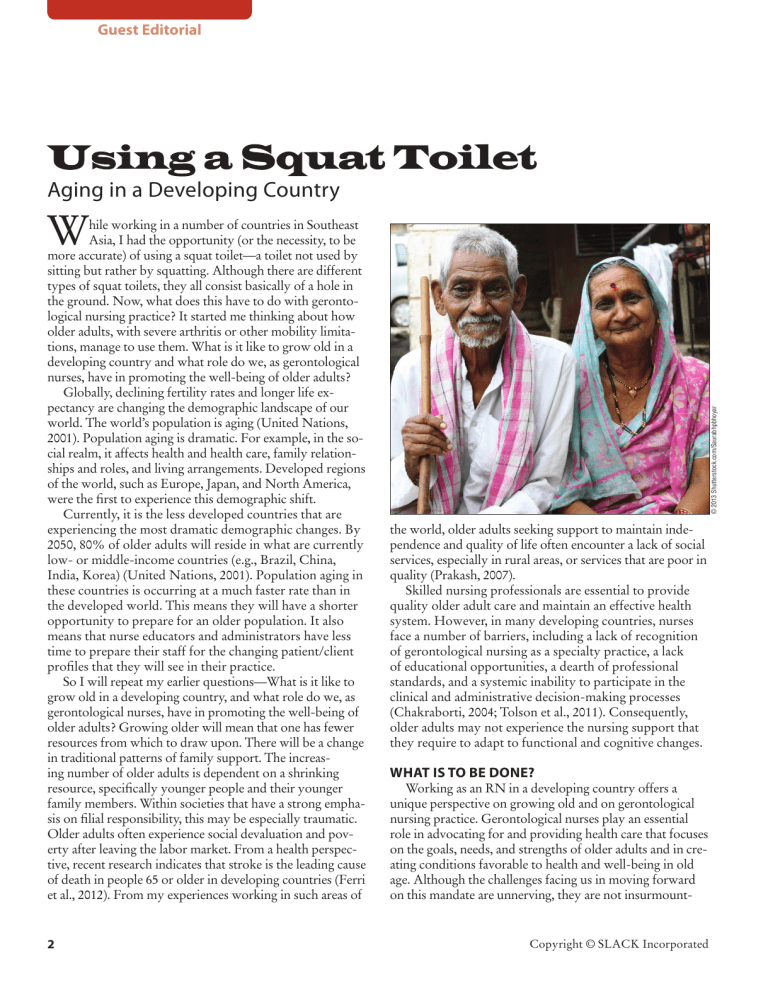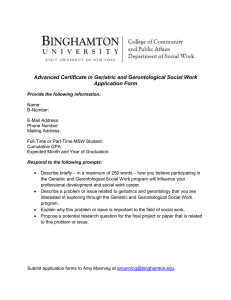Aging in Developing Countries: A Gerontological Nursing Perspective
advertisement

Guest Editorial Aging in a Developing Country hile working in a number of countries in Southeast Asia, I had the opportunity (or the necessity, to be more accurate) of using a squat toilet—a toilet not used by sitting but rather by squatting. Although there are different types of squat toilets, they all consist basically of a hole in the ground. Now, what does this have to do with gerontological nursing practice? It started me thinking about how older adults, with severe arthritis or other mobility limitations, manage to use them. What is it like to grow old in a developing country and what role do we, as gerontological nurses, have in promoting the well-being of older adults? Globally, declining fertility rates and longer life expectancy are changing the demographic landscape of our world. The world’s population is aging (United Nations, 2001). Population aging is dramatic. For example, in the social realm, it affects health and health care, family relationships and roles, and living arrangements. Developed regions of the world, such as Europe, Japan, and North America, were the first to experience this demographic shift. Currently, it is the less developed countries that are experiencing the most dramatic demographic changes. By 2050, 80% of older adults will reside in what are currently low- or middle-income countries (e.g., Brazil, China, India, Korea) (United Nations, 2001). Population aging in these countries is occurring at a much faster rate than in the developed world. This means they will have a shorter opportunity to prepare for an older population. It also means that nurse educators and administrators have less time to prepare their staff for the changing patient/client profiles that they will see in their practice. So I will repeat my earlier questions—What is it like to grow old in a developing country, and what role do we, as gerontological nurses, have in promoting the well-being of older adults? Growing older will mean that one has fewer resources from which to draw upon. There will be a change in traditional patterns of family support. The increasing number of older adults is dependent on a shrinking resource, specifically younger people and their younger family members. Within societies that have a strong emphasis on filial responsibility, this may be especially traumatic. Older adults often experience social devaluation and poverty after leaving the labor market. From a health perspective, recent research indicates that stroke is the leading cause of death in people 65 or older in developing countries (Ferri et al., 2012). From my experiences working in such areas of 2 © 2013 Shutterstock.com/Saurabhpbhoyar W the world, older adults seeking support to maintain independence and quality of life often encounter a lack of social services, especially in rural areas, or services that are poor in quality (Prakash, 2007). Skilled nursing professionals are essential to provide quality older adult care and maintain an effective health system. However, in many developing countries, nurses face a number of barriers, including a lack of recognition of gerontological nursing as a specialty practice, a lack of educational opportunities, a dearth of professional standards, and a systemic inability to participate in the clinical and administrative decision-making processes (Chakraborti, 2004; Tolson et al., 2011). Consequently, older adults may not experience the nursing support that they require to adapt to functional and cognitive changes. WHAT IS TO BE DONE? Working as an RN in a developing country offers a unique perspective on growing old and on gerontological nursing practice. Gerontological nurses play an essential role in advocating for and providing health care that focuses on the goals, needs, and strengths of older adults and in creating conditions favorable to health and well-being in old age. Although the challenges facing us in moving forward on this mandate are unnerving, they are not insurmount- Copyright © SLACK Incorporated able. There are strategies that we, as gerontological nurses, can implement on our own to promote the well-being of older adults; for other strategies, we can work in collaboration with nongovernmental organizations, governments, and health care colleagues. These strategies include: l Advocating for provision of government-funded pensions and benefits sufficient to protect older adults against extreme poverty. l Promoting the provision of basic primary health care services to support the long-term care of those with functional and cognitive deficits. l Educating—placing a greater emphasis on health itself— through policies that serve to prevent chronic disease. l Supporting the professional education of nurses through online training opportunities. l Ensuring undergraduate gerontological nursing courses offer commentary on aging and working in developing countries. l Using gerontological nursing to develop international partnerships. l Assisting in developing and evaluating frameworks for gerontological nurse training and education in developing countries (see Wilimas et al., 2003). When working in a developing country, I moved from the theory of understanding that the care of older adults would be culturally different to experiencing what this meant in my own nursing practice. I expect boundaries, ethics, and nursing and health care practices to be different. I expect to use in-country resources versus bringing those that I used on the nursing units at home. I learned how to use a squat toilet, although I still like a bathroom door. However, what never changes is my commitment to quality care for older adults. REFERENCES Chakraborti, R.D. (2004). The graying of India: Population ageing in the context of Asia. Thousand Oaks, CA: Sage. Ferri, C.P., Acosta, D., Guerra, M., Huang, Y., Llibre-Rodriguez, J.J., Salas, A.,…Prince, M.J. (2012). Socioeconomic factors and all cause and cause-specific mortality among older people in Latin America, India, and China: A population-based cohort study. PLoS Medicine, 9, e1001179. doi:10.1371/journal.pmed.1001179 Prakash, I.J. (2007). Psychological issues in ageism and its prevention. Indian Journal of Gerontology, 21, 206-215. Tolson, D., Rolland, Y., Andrieu, S., Aquino, J.P., Beard, J., Benetos, A.,... Morley, J.E. (2011). International Association of Gerontology and Geriatrics: A global agenda for clinical research and quality of care in nursing homes. Journal of the American Medical Directors Association, 12, 184-189. doi:10.1016/j.jamda.2010.12.013 United Nations. (2001). World population ageing: 1950 to 2050. Retrieved from http://www.un.org/esa/population/publications/worldageing19502050 Wilimas, J.A., Donahue, N., Chammas, G., Fouladi, M., Bowers, L.J., & Ribeiro, R.C. (2003). Training subspecialty nurses in developing countries: Methods, outcome, and cost. Medical and Pediatric Oncology, 41, 136-140. Sandra P. Hirst, PhD, RN, GNC(C) Director Brenda Strafford Centre for Gerontological Nursing University of Calgary Calgary, Canada The author has disclosed no potential conflicts of interest, financial or otherwise. doi:10.3928/00989134-20130604-01

